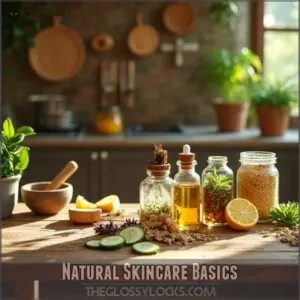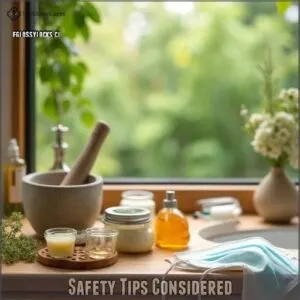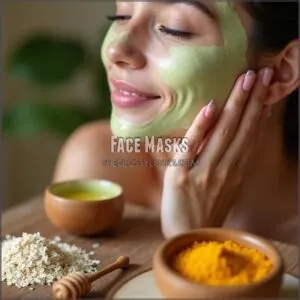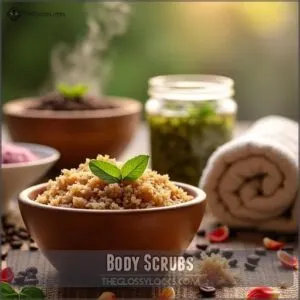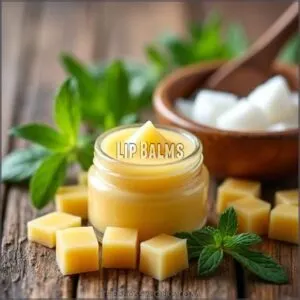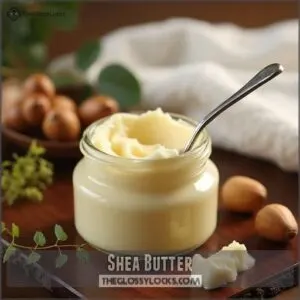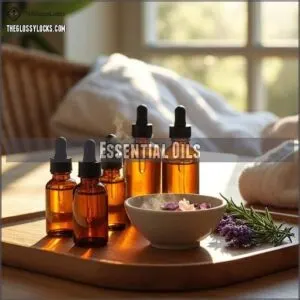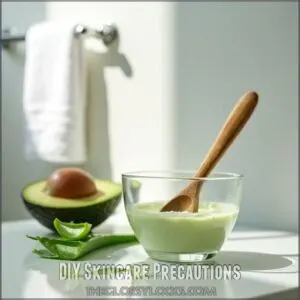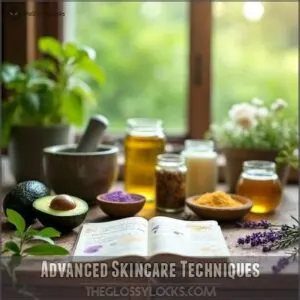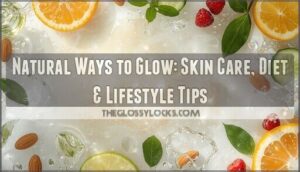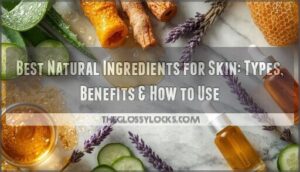This site is supported by our readers. We may earn a commission, at no cost to you, if you purchase through links.
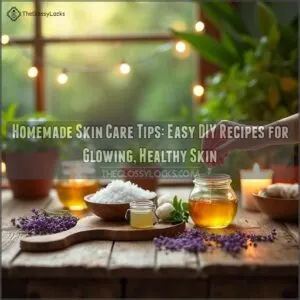 You’ll love these homemade skin care tips that transform your bathroom into a natural spa sanctuary. Start with kitchen staples like coconut oil and honey for deep hydration, or mix up a gentle scrub using mineral salts.
You’ll love these homemade skin care tips that transform your bathroom into a natural spa sanctuary. Start with kitchen staples like coconut oil and honey for deep hydration, or mix up a gentle scrub using mineral salts.
For sensitive skin, chamomile and aloe vera work wonders to calm irritation. Always test new ingredients on a small patch first – your skin’s as unique as you are!
Keep your DIY creations in clean glass jars, and source organic ingredients when possible. From brightening turmeric masks to soothing lavender toners, nature’s medicine cabinet holds countless secrets for achieving that coveted healthy glow.
Table Of Contents
Key Takeaways
- Use natural ingredients like coconut oil, honey, and aloe vera to hydrate, soothe, and brighten your skin safely.
- Always patch test new recipes to prevent allergic reactions or irritation, especially if you’ve got sensitive skin.
- Store homemade products in clean glass jars and stick to small batches to avoid bacteria growth and maximize freshness.
- Customize recipes to match your skin type by swapping or adding ingredients like tea tree oil for acne or extra coconut oil for dry skin.
Natural Skincare Basics
You don’t need fancy products to build an effective skincare routine—many ingredients are already in your kitchen.
By using simple tools and sourcing organic options, you can create safe, natural remedies suited to your skin’s needs.
Essential Ingredients
The magic of natural skincare starts with powerful ingredients. Here’s your go-to list:
To find the best natural oils products, consider the ingredients and their benefits.
- Natural Oils – Coconut, jojoba, and argan hydrate like a dream.
- Herbal Extracts – Chamomile and lavender calm your skin naturally.
- Plant Compounds – Aloe vera or turmeric for an instant glow.
- Amino Acids – Repair and restore skin health.
- Mineral Salts – Detoxify and balance skin effectively.
Common Kitchen Tools
Your kitchen holds plenty of tools perfect for homemade skincare.
Mixing bowls help blend ingredients smoothly, while measuring cups keep recipes accurate.
Wooden spoons and silicone spatulas are gentle yet effective for stirring.
Store your creations in glass jars to keep them fresh.
When shopping for essential Mixing Bowls, consider the material and size for your skincare needs.
These simple tools make your DIY skincare routine easy, efficient, and a fun addition to natural skin care.
| Tools | Purpose | Notes |
|---|---|---|
| Mixing Bowls | Ingredient blending | Use non-metal to avoid reactions. |
| Measuring Cups | Recipe precision | Guarantee exact measurements. |
| Glass Jars | Storage | Keep mixtures airtight and fresh. |
Sourcing Organic Ingredients
When whipping up your natural skin care goodies, organic ingredients are a game changer.
Check local markets for fresh finds or explore green suppliers specializing in eco-friendly, sustainable sourcing.
Look for labels like USDA Certified Organic or connect with organic farming communities nearby.
Organic beauty tips often start with pure natural ingredients, giving your skin the love it deserves—chemical-free and guilt-free!
Safety Tips Considered
When creating your own skincare, it’s important to prioritize safety to protect your skin and health.
By understanding potential allergens, harmful ingredients, and how products interact with your skin, you can avoid common DIY mistakes.
Allergy Considerations
Got sensitive skin? Allergic reactions can hit like a plot twist, leaving rashes or redness behind. Watch out for irritant ingredients like fragrances, essential oils, or dyes—they’re top skin allergy culprits.
To learn more about common allergens, research and understand the ingredients in your skin care products.
Stick to hypoallergenic products and test DIY recipes on a small patch first. Protect against skin irritations by avoiding toxic ingredients and choosing allergy-friendly options every time.
Harmful Ingredients
Do you know what’s lurking in your skincare? Toxic chemicals like parabens and phthalates can lead to hormone disruptions, while artificial fragrances trigger skin irritations—especially for sensitive or acne-prone skin.
When creating your own products, consider using natural preservatives to guarantee safety and effectiveness. Harsh preservatives and chemical additives, including formaldehyde, are common culprits hiding in products.
Swap these toxic ingredients for natural alternatives to protect your skin and avoid harsh reactions.
Skin Absorption
Your skin isn’t just a shield; it’s a sponge. Every ingredient you apply in your homemade skin care penetrates layers, affecting your skin barrier.
While nutrient uptake can nurture skin health, harmful substances may lead to toxic entry. Opt for natural skincare tips in your routine—ingredients like aloe or coconut oil support cellular penetration safely while helping minimize pore size.
DIY Skincare Benefits
Creating your own skincare products lets you tailor recipes to suit your unique needs while saving money.
Plus, it’s a more eco-friendly option that helps reduce packaging waste and harmful chemicals.
Customized Recipes
Homemade skincare gives you the freedom to tailor solutions that fit your skin type.
From recipe tweaking to ingredient swapping, it’s all about finding what works for you.
Need hydration? Adjust formulas with honey or aloe.
Fighting acne? Add tea tree oil.
With homemade beauty recipes, the possibilities are endless, offering control and creativity in your skincare routine.
Cost-Effective
Tailoring recipes to your needs isn’t just fun—it’s a total game-changer for your wallet. DIY skin care offers Budget Beauty with Affordable Skincare options using simple, cheap alternatives from everyday ingredients.
Learning about natural skin care can help you create effective products.
Why spend a fortune when you can:
- Reuse kitchen staples like honey or oatmeal.
- Skip pricey store brands.
- Make Economical Products that last.
- Embrace Frugal Tips for natural skincare.
Environmentally Friendly
Switching to natural skincare lets you embrace green beauty while reducing waste.
Using DIY skincare with natural ingredients cuts down on plastic packaging and harmful chemicals, bringing zero-waste goals closer.
Organic skincare recipes also support sustainable living by skipping mass production.
Eco-friendly tips like repurposing glass jars for storage make homemade skincare an easy, planet-friendly choice!
Homemade Skincare Recipes
You can create simple, effective skincare products at home using natural ingredients like honey, coconut oil, and oatmeal.
These easy recipes help you target specific skin concerns while saving money and avoiding harsh chemicals.
Face Masks
Homemade face masks are game-changers for natural face care.
Tailor them to your skin type using simple mask ingredients like honey for hydration, oatmeal for soothing, or turmeric for brightening.
Apply on a clean face, let the nutrients work their magic, and rinse gently.
You can find various homemade face care recipes that cater to different skin concerns.
This DIY skincare ritual offers glowing facial benefits without breaking the bank—your skin will thank you!
Body Scrubs
Body scrubs are a game-changer for Skin Smoothening. A DIY sugar scrub gently exfoliates, while Salt Scrubs offer deeper cleansing.
For the best Sugar Body results, consider combining natural ingredients with store-bought products.
Try a DIY coffee body scrub to tackle Cellulite Reduction or a DIY lemon body scrub for a radiant glow. Feeling fancy? A rose petal body scrub doubles as Body Polish, leaving your skin silky smooth and pampered.
Lip Balms
Cracked lips ruining your day? Whip up a homemade lip balm using beeswax, coconut oil, and a drop of your favorite natural flavor like peppermint or vanilla.
For smooth lips, start with a DIY lip scrub—mix honey and sugar for easy lip exfoliation. These simple homemade recipes give you control over balm ingredients and offer the perfect DIY lip care solution.
Skincare Routine Tips
Creating an effective skincare routine helps you maintain healthy, glowing skin while addressing your specific needs.
By balancing consistency with the right homemade products, you can keep your skin nourished and refreshed every day.
Morning Routine
Kickstart your morning skincare routine with a quick cleanse using a diy skin care recipe like oatmeal and honey to gently refresh your face.
Follow up with a hydrating toner, such as rosewater, to awaken your skin.
For that wake-up glow, add a light homemade moisturizer packed with aloe or jojoba oil.
Daily exfoliation? Keep it gentle, maybe twice weekly.
Nighttime Routine
End your day with a relaxing nighttime skincare routine. Remove makeup thoroughly, then cleanse to refresh your skin.
Apply a hydrating toner and follow up with homemade skin care products like night creams or bedtime masks. Evening exfoliation? Skip it here—save that for another step.
Finish with relaxation techniques to boost circulation and calm your mind.
Exfoliating Schedule
Exfoliation keeps your skin texture smooth and improves glow, but overdoing it disrupts balance. After your nightly cleanse, consider exfoliating weekly using natural exfoliants like a DIY exfoliating facial scrub.
Here’s what works:
- Gentle Methods: Try an exfoliating sugar face scrub.
- Frequency Control: Once weekly for dry skin.
- Oily Types: Twice weekly with homemade exfoliants.
- Acne-Prone Skin: Opt for mild options.
Natural Ingredients Explained
In the context of DIY skincare, understanding natural ingredients is key to creating effective, safe recipes.
You’ll learn how staples like coconut oil, shea butter, and essential oils contribute to healthier, glowing skin.
Coconut Oil
Speaking of homemade skin care, coconut oil’s versatility shines.
It’s a game-changer for dry skin, thanks to its rich hydration, and is packed with natural benefits.
Use it for diy skin care like coconut masks or moisturizers, but skip acne-prone areas.
Though it’s a staple in natural beauty tips, patch test first—everyone’s skin type dances to its own tune.
Shea Butter
Shea butter is your go-to for skin nourishment and homemade skincare. Packed with vitamins A and E, it’s a natural powerhouse for softening and repairing dry skin.
When considering shea butter types, to maximize its benefits, you need to understand the differences.
Use it as:
- A body moisturizer for dry elbows or knees
- Facial cream for hydration
- A lip balm base
- Hair care to tame frizz
- A luxurious addition to homemade beauty tips
Essential Oils
Essential oils are powerhouse skincare ingredients in homemade skincare.
From calming lavender to acne-busting tea tree, they cater to all skin types.
Perfect for oil blending, they enhance natural skincare recipes with fragrance uses and aromatherapy benefits.
Always dilute before use, as proper oil extraction guarantees safety.
Essential oils transform DIY skincare products into luxury self-care rituals you’ll love!
DIY Skincare Precautions
When you’re making your own skincare products, it’s important to understand the potential risks like bacterial growth and allergic reactions.
Taking simple precautions, like properly storing your creations and testing for sensitivities, keeps your DIY routine safe and effective.
Preservatives
Water-based homemade skincare needs natural preservatives to prevent spoilage.
Ingredients like aloe vera or hydrosols aren’t chemical-free without them.
Natural preservatives, such as Geogard ECT or potassium sorbate, extend shelf life and maintain product stability.
Don’t confuse antioxidants like vitamin E with true preservatives—they won’t stop bacteria.
For safer homemade skin remedies, stick to trusted natural beauty tips and follow guidelines.
Bacteria Growth
Your homemade skin care routine needs smart microbe management to stay safe.
Your natural skin care products can become a cozy home for unwanted bacteria, especially in water-based formulas.
Here’s how to master contaminant control:
- Make small batches to guarantee freshness
- Use sanitized tools and containers for germ prevention
- Store products in a cool, dry place for maximum preservation
Allergic Reactions
Being proactive about allergic reactions in your DIY skin care routine starts with smart patch testing.
Take control of skin health tips by applying a small amount to your inner arm before committing to a full application.
Understanding reaction symptoms helps you stay ahead of potential issues:
| Common Ingredient | Warning Signs | Risk Level | Safety Steps |
|---|---|---|---|
| Natural Extracts | Redness, Itch | Moderate | 24-hr Test |
| Plant Oils | Burning, Rash | Low-Medium | Dilute First |
| Fruit Acids | Stinging, Peeling | High | Spot Check |
| Raw Botanicals | Swelling, Heat | Variable | Allergy Test |
Advanced Skincare Techniques
You’ll discover how to combine natural ingredients in the right order and create custom recipes that work specifically for your skin type.
Once you’ve mastered these advanced techniques, you’ll be able to troubleshoot common skin issues and adjust your homemade skincare products for the best results.
The key to success lies in understanding how to combine natural ingredients and create custom recipes that cater to your individual skin type.
Layering Products
Smart product stacking can make or break your homemade skin care routine. Just like building a house, the order of your skin care products matters for maximum effectiveness. Start with cleansing to create a clean foundation for what comes next.
- Layer water-based products first to maintain proper moisture levels and enhance skin texture
- Apply serums from thinnest to thickest for ideal product compatibility
- Lock everything in with oil-based creams to protect your skin care routine’s work
Customizing Recipes
You’ve mastered product layering, now let’s make those DIY skincare recipes truly yours.
Different skin types need different care – swap honey for aloe vera if you’re oily, or add extra coconut oil for dry patches.
Play with product texture by adjusting liquid ratios, and personalize fragrance options using your favorite essential oils.
These homemade skincare recipe tweaks guarantee your DIY routine perfectly matches your skin’s needs.
Troubleshooting Skin Issues
The journey to clear skin starts with understanding your unique challenges.
For acne-prone skin and redness relief, try natural remedies like shiitake mushroom masks or vitamin C-rich citrus toners.
Combat hyperpigmentation with soy-based treatments while sensitive skin responds well to chamomile and red seaweed extracts.
These skin care remedies work best when paired with consistent daily care.
Frequently Asked Questions (FAQs)
What is the best homemade skin care?
Start with natural moisturizers like coconut oil and honey for daily care.
Mix in vitamin C serums from citrus fruits, and create gentle exfoliants using oatmeal or sugar.
Don’t forget rosewater toner for balance.
How can I treat my skin naturally at home?
Treat your skin naturally by using simple remedies like honey masks for hydration, oatmeal scrubs for gentle exfoliation, and aloe vera for soothing.
Stay consistent, moisturize daily, and protect your skin from the sun’s harsh rays.
How can I make a skin care routine at home?
Over 60% of what you apply to your skin gets absorbed.
Build a DIY routine with a gentle cleanser, natural toner, moisturizing oils, and weekly masks.
Experiment with ingredients like aloe, honey, or rosewater for glow-worthy results.
How can I make my own skin care?
Mix natural ingredients like honey, aloe vera, or coconut oil to create masks, scrubs, and moisturizers at home.
Follow simple recipes, patch-test for safety, and tweak formulas to suit your skin’s unique needs.
How long do homemade skincare products stay fresh?
Think of homemade skincare like fresh produce—it doesn’t last forever.
Most products stay fresh for 1-2 weeks in the fridge.
Without preservatives, bacteria can grow quickly, so small batches work best.
Conclusion
Think of your skin like a garden—it thrives with care, the right ingredients, and a little patience.
Using these homemade skin care tips, you can create simple, effective recipes that work for your unique needs while keeping it budget-friendly and sustainable.
From soothing masks to hydrating body scrubs, the possibilities are endless with natural ingredients.
Take time to experiment and perfect your routine, and watch your skin glow from the inside out. Your DIY spa awaits!

